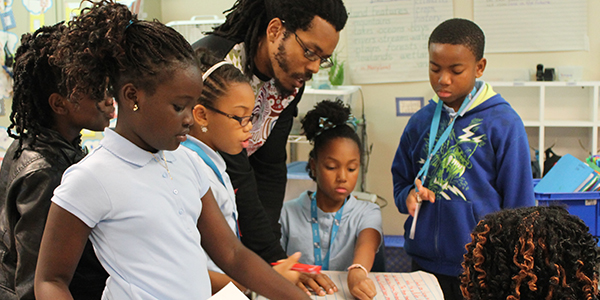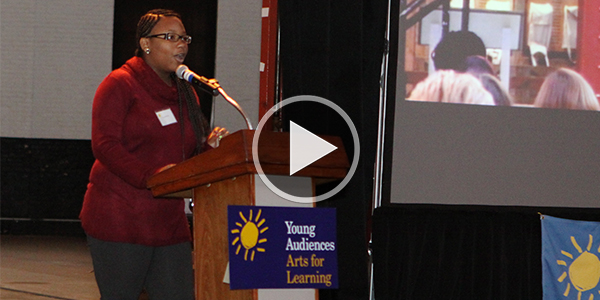Blog
Communicating through Hip Hop
By Bomani, Young Audiences teaching artist and Hip Hop poet
Before my recent residency with fourth-graders at Scholars K-8 in Baltimore County began, the teachers I worked with–Mrs. Brumbalow, Ms. Barnes, and Ms. Hicks–had prepared the students for my arrival. When I walked through the door on the first day, the students recognized me and treated me like a rock star, so I knew I had to make a meaningful impact.
At the beginning of a residency, there are three writing rules I give students:
- Artists don’t make mistakes, they make discoveries.
- Do not edit in your head.
- The only wrong answer is a blank answer.
Students are oftentimes drilled to memorize answers in order to score highly on assignments. Sometimes they become paralyzed with fear when asked their opinion, so I try to loosen them up to think creatively. Young people need to have freedom to develop an idea out loud without self-doubt and to not fear right or wrong answers.
I worked with the Scholars K-8 teachers to create a series of Hip Hop writing workshops to strengthen students’ comprehension skills. In the two weeks I was at the school, students wrote songs about the writing process, how to count money and use decimals, as well as climate and how humans affect the environment.
The initial challenge was getting students excited about writing. They were energized by Hip Hop poetry writing because it’s a style of music they admire beyond the school setting.

Once they got used to the idea that we weren’t looking for one correct answer, they felt free to say what they were thinking. There was one student in particular whose reading and comprehension skills were not where they should have been for his grade level. One of his teachers revealed that this residency was one of the few opportunities where he felt confident enough to answer questions because he could take his time and work through his ideas out loud. Each day he was fighting through the door for the front seat, and his self-esteem was boosted each time he answered a question.
During an exercise, we discussed the music video “Me, Myself, and I” by De La Soul which includes symbolism about self-acceptance. The light bulb went off for many students, who immediately related to trying to fit in or be cool. They realized that at some point, you have to validate yourself without caring about the opinion of others. To see them react to that song, and have students come in the next day writing lines I didn’t assign, was a very powerful feeling. They were using art to reflect their realities and project their hopes for the future.
There was one point during the residency that I had to put my “teacher” foot down when a student became disruptive while we were writing the chorus of a song. Students that age can struggle with differentiating positive and negative attention, but when we got down to the last line, that student raised his hand and offered a new idea to our brainstorming session. The line was exactly what we needed and the whole class recognized him for it. To be validated like that after being reprimanded showed him that we wanted him to participate and be a part of the team, but in a constructive way.

This residency strengthened their class bonds by allowing students to collaborate and recognize each other’s talent. Even students who often had problems dealing with their classmates or paying attention were invested. They appreciated each other’s creativity and when they were put into groups to write on their own, they just took off.
One of the main complaints I get from young people is that they aren’t understood. My response is always that they need to improve their communication. The ability to speak, write, and create art in a way that others can comprehend is something students latch onto, and they internalized the techniques I gave them. We would brainstorm an idea, flesh out a paragraph on this idea, and then break the paragraph into a rhyme. While writing the song, they formulated introductory and supporting paragraphs. Before they knew it, they had completed an essay. The process made them realize how much they want this skill. One student gave me a poster she made outside of class time with an anagram for my name. Her classmates loved it so much they all signed it and gave it to me. I still don’t think I’ve come down from that high.
Learn more about Bomani and his programs for schools at yamd.org.
December smART Tip from Christina Delgado

In our December smART Tip, Young Audiences visual artist Christina Delgado shares how to organize a photo scavenger hunt for students that can easily be tailored to connect with any subject or unit. Learn how to get started with this fun activity in the short video below.
[youtube http://youtu.be/rWIGPp_NTOs?list=PLUssR-3GtBZfiKXpU72zQAkgXh3wBcBzQ]
smART Tips is a monthly video series sharing tips for educators who are interested in new, creative ways to use the arts in their classroom with students. See all smART Tips to date here. Interested in a specific topic? Let us know!
Exploring Earth’s treasures

Photos and content were originally posted on Daneytt Tucker’s blog “Daj’zha Vu” here and here.
This fall, Young Audiences visual artist Danyett Tucker worked with John Hanson Montessori middle school students to create a mural that now brightens their school hallway.
The theme for the eight, two- by four-foot wood panels is “Earth’s Treasures.” Danyett explains how the project began:
“I Googled “earth’s treasures” and found [the poem] ‘A Lunar Lament’ by Ann Pedtke. After I read the poem to the class for inspiration, I asked them to imagine that they were the moon looking down upon the earth, marveling at its treasures. What treasures would make you a jealous moon? They came up with some great sketches, which I pieced together into our mural composition, all from the moon’s perspective.”

The four week-long residency was a powerful experience for all involved. Danyett writes, “I am so proud of the students at John Hanson Montessori. They are creative, focused, and fun! They made me feel like a part of their family.”
Read more about this residency (and see photos from all stages of the project!) on Daneytt’s blog “Daj’zha Vu” here and here.
Meet our artists: Mark Lohr

Young Audiences’ roster of artists continues to grow to encompass new artists, ensembles, and art forms, from slam poets to improvisers to Capoeira masters.
We’ll be regularly posting interviews with our artists, giving them a chance to share more about themselves and their experiences bringing their Young Audiences programs to schools.
How did you hear about Young Audiences? What made you decide to become a roster artist?
I started my apprenticeship with Theatricks Theatre Company, where my performing mentor had a show as a Young Audiences roster artist. I took a break from performing for a bit, and when I decided to come back I immediately thought of Young Audiences as a great organization to work with because of my past experience. I have been on the roster for about 10 years now.
Can you tell us a little bit about your art form?
My art form is Vaudeville-style physical comedy. During the performances, I interact with the audience nonverbally and become a combination of circus clown, comic actor, juggler, and magician.
The creation of vaudeville is such an influential time in our history. Entertainment was revolutionized for the vaudeville stage, and technologies were invented to make shows more impressive using special effects, lighting, and more. We don’t have an opportunity to see that style of slapstick, nonverbal comedy anymore.
How do the lessons and skills you teach students through your art form apply to their everyday lives outside of the classroom?
During a vaudeville performance, students have to listen more with their eyes than ears. They have to interpret what my character is communicate without words and respond accordingly. Sitting there and taking it in with all their senses gets them involved. In a typical theatrical performance, there is a “fourth wall.” There is a performance or show, but the audience is on the other side of that fourth wall so there is no interaction. I put the wall behind the audience so each performance is a new experience–you never know what you’re going to get with each crowd that comes in.

The performance becomes a shared memory for students. It’s multi-cultural and multi-generational entertainment. You bring a school together with a performance where they laugh and have a great time. They share that wonderful memory, and can relate to each other more because of it.
Why do you believe theater is important for every student to have access to?
Vaudeville is such an important era in our history that we shouldn’t forget. It has a great significance in our culture today. Television shows like “America’s Got Talent” and “The Voice” follow in the tradition of vaudeville.
But a live performance is so important because, all too often, many students’ primary performance venue is a television or movie theater. There is nothing wrong with these things, but when you go to a live performance you’re immersed and surrounded by it so that you become a part of it. I feel that it is my job to reach out to schools and students who may never have the opportunity to see a live professional performance. In our education, it’s extremely important to give students that experience.
How does your art form help connect students to what they are learning in school?
“Hooked on Books” is my reading program where the audience has to listen and develop a response to everything I do. The main lesson I want them to walk away with is that books are more than stories, they are also gateways to new skills! I also share that it is OK to experience failure because to learn a new skill you have fail. The idea that failure isn’t a bad thing, but a part of the process, is a wonderful lesson.
What has been the most memorable part of the programs you’ve brought to students with Young Audiences?
From a performance standpoint, to be able to engage these students and have them become a part of my performance is a wonderful gift to me, and it’s my gift to them. They are laughing, responding to what I’m doing, enjoying the moment, and not thinking about what’s going to happen in the next hour.
In my residency, “America’s Got Vaudeville,” I talk about the significance of vaudeville and teach its skills and comic techniques. Our goal is to put on a show at the end. When I see there is a student who sits out in the corner not quite fitting in, I can reach out to them and teach him or her juggling or plate-spinning, and see his or her whole person change. They discover they have a new talent and skill and can share it with their classmates. Their peers begin to see each other in a different light and overcome social and cultural boundaries. They share a common bond. The look on students’ faces when they succeed in a new skill for the first time is a huge reward for me.
What is the most rewarding aspect of being a Young Audiences roster artist?
Young Audiences gives me the opportunity to share gifts that were given to me. My mentor gave me this knowledge with the one caveat of having to share it. It’s so important for me to have different venues where I can go out and give it away, and can see people walking away with a piece of the gift that was given to me. It impacts people’s lives, and I’m grateful that Young Audiences allows me to do that.
Learn more about Mark Lohr’s offerings through Young Audiences.
Keep an eye out for more artist interviews! See all artist interviews to-date here.
Drawing it out

By Cyan McMillian, seventh-grade student, Windsor Hills Elementary/Middle
My name is Cyan McMillian and I am a seventh grader at Windsor Hills. I’d rather throw a football than paint my nails (seriously). I felt like a free spirit until my tenth birthday–which was the worst day ever. I was excited but made the mistake of not bringing enough cupcakes for the whole class. One girl–the drama queen–decided to take out her frustrations on me. She waited until we got in the cafeteria and took a mixture of yogurt, milk, juice, and water and poured it over my head in front of everyone. On my birthday! Everyone who saw it laughed. Even the adults. I was so hurt and embarrassed that I ran out of the cafeteria in tears.
I never wanted any friends after that. The more I tried to be myself the more I would get picked on. Bullies targeted me for all the ways that I was different–my weight, my clothes, and my love for school.
My parents signed me up for the Baltimore City summer learning academy, the summer before middle school started. I like math and science, but I was most interested in the art classes provided by Young Audiences. See, I don’t get to enjoy the liberties of art during the school year. Having art every day during the summer was a treat because I got to make new friends, I learned how to use the color wheel, how to make 2D pictures become 3D pictures.
Watch Cyan share her story at Young Audiences’ Impact Breakfast event earlier this month!
My art class was taught by Young Audiences teaching artist, Danyett Tucker. She played a song by Lauryn Hill called “Everything is Everything,” and asked us to illustrate what the lyrics meant to us. I love that song. It was like math because my hands and brain were working at the same time to solve a problem. I was able to express myself without being judged in a way that was fun and challenging. I learned from Ms. D that there is no “right” or “wrong” when it comes to art.
Ms. D believed in me and gave me the confidence to believe in myself. She let me come to her when I needed someone to talk to and gave me helpful advice when I was stuck. I was free to be who I am again, which made me feel like my old happy-go-lucky free-spirited self.
Ms. D inspired me to keep drawing after the program was over. My dad loves to draw and after that summer we started drawing together. When I found out the summer program was going to happen again this summer, I found out where Ms. D was teaching and signed up. This summer was even better because not only did I get art with Ms. D, other artists also helped teach the science and math classes. I learned how ratios relate to music and how dance movements connect with science.
In Ms. D’s class, we created a mural that’s displayed here today illustrating Maya Angelou’s poem, “A Brave and Startling Truth.” The poem was confusing at first but the more we read it as a class it became easier to understand and inspired me to speak out about the positive and negative things that happen around me. I was able to use my voice through illustration again. I attended this program every single day and now I have two murals in my portfolio.

Now when I feel like I have something to express but don’t know how to say it, I draw it out. Thanks to Young Audiences, I have learned a lot about myself. I’m more observant and I know what a real friend is. I know who I am. So what if I’m not a girly girl, I’m fast and I can handle my business. When they call my clothes trashy, I don’t let it bother me because their shiny white sneakers always end up dirty in a few days. And when they talk about my weight, like the song “All About That Bass” says: “Every inch of me is perfect from the bottom to the top!”
Last year I had the highest grade point average in middle school and it is still sky-high. I have a scholarship to any college that I want. I plan to get a PhD and work for NASA. Thanks to the support of my family, a few good friends, and the Young Audiences artists who understand me like a parent would, I am going for my dreams. And while the summer program is over, what I learned from Ms. D, that “Everything is Everything,” will stay with me forever. What that means to me is that if you want to be something and you work hard, you will most likely become that. So keep an eye out for me.
Meet our new artists: FutureMakers
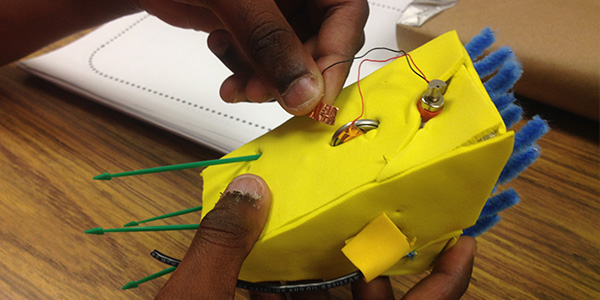
During the last two years, our roster has grown in size to encompass new artists, ensembles, and art forms. From slam poets to improvisers to Capoeira masters, these new artists are undeniably unique.
To introduce audiences to our new artists, we’ll be posting interviews with those who recently joined our roster, giving them a chance to share more about themselves and their experiences with Young Audiences so far. We recently sat down with Matt Barinholtz of FutureMakers.
What is your background as an artist?
FutureMakers started from work I was doing as a visual artist and sculptor with other makers and educators. I was frequently asked if I could bring the type of work I was doing to classrooms. I had met artists, engineers, and technologists that wanted to do projects with young people, but didn’t feel confident about how to approach it. I wondered if an organization could connect makers and educators, so both could build their skills.
During the summer of 2012, I was invited to work with a supportive cohort of community colleges in Maryland to bring STEAM workshops (Science, Technology, Engineering, Arts, Mathematics) into their summer programs for youth. Since then, we’ve steadily been growing our staff, or as we call them, coaches, and are excited to be working with Young Audiences to provide a formal pathway for those interested in joining FutureMakers to deliver programs to schools.
How did you hear about Young Audiences?
Someone shared a workshop offered by Pat Cruz, Young Audiences Education Director. I wasn’t able to attend, but reached out to Pat to find out how FutureMakers could learn from and work with Young Audiences. In 2013, we were invited to support a summer learning program in Harford County, and participate in the Teaching Artist Institute (TAI) Seminar. Through TAI, we developed a FutureMakers residency. We’ve been making things that wiggle, draw, glow, and do crazy stuff with kids ever since.
See these sculptures in action here!
What has been the most memorable part of the programs you’ve had through Young Audiences?
I was watching morning announcement videos at a school which used puppets created by students with TAI instructor and playwright John Morogiello. They were funny and sharp. It wasn’t about adults, it was about youth development with young people out in front. I was impressed by the way art was completely integrated into that school. It made me wish that more places would work and integrate this way.
What was your favorite part of the Teaching Artist Institute (TAI) Seminar? How has the experience changed your approach to teaching?
TAI solidified the way we at FutureMakers think about the pathway our coaches follow. It focuses our expertise and creativity on student engagement, measurable outcomes, and addresses the needs of our teacher partners. They get to see and do what they’d like within boundaries of what they need to do.
Our coaches are experiencing how maker education can connect in classrooms because of Young Audiences. Being observed, receiving feedback, and having scheduling and communications support is an enormous value that Young Audiences adds to our organization.
What does your art form–particularly as it relates to STEM subjects–teach students?
With technology, things are moving toward additive processes – for example, 3D printing, which is a process we incorporate in many community workshops. Traditional craft and art media are now expanding to incorporate materials often found in science or technology classrooms, or only available to higher education students. In a rapidly evolving, project-based learning world, coaches help young people embrace the design process in their creative lives – think like engineers to figure out how to solve a design challenge, and have the confidence to iterate, or try again, when things go in unexpected directions.
How do the lessons or skills you teach students apply to their everyday life outside of the classroom?
Students asking, imagining, planning, creating, and improving is the core of what we’re about. Young people have limitless imaginations, and are open to learning how to take a step back and ask questions. In the past, young makers followed plans or prescriptive examples to complete a project. We’re learning that truly effective coaches facilitate their discovery of paths and options that lead to mastery – supported by the design cycle.
Why do you believe art is important for every student to have access to?
Young people need to have the opportunity to try something and fail, and a coach who can help them through difficult spots. Art was the only thing that kept me focused and motivated in high school; it was my identity early on. When we’re working with students in upper-elementary and middle school, identity is a large and important part of what our residencies are about. Art is a fast path to forming and grabbing onto an identity, whatever the content is.
What is the most rewarding aspect of being a Young Audiences roster artist?
It’s incredibly validating to know as an organization we’re doing something that our school systems embrace. I think the most rewarding aspect is knowing that we’re working in a community of other practitioners who are phenomenal performing and visual artists and amazing coaches. That is a very rare mix, and we’re honored to be a part of it.
Learn more about FutureMakers’ offerings through Young Audiences.
Keep an eye out for more interviews featuring our newest roster artists! See past new artist interviews here.
November smART Tip from Katherine Dilworth

History and social studies curriculum can include subjects that are difficult to address. The brutality of past atrocities, such as the Holocaust and genocide in Rwanda, can be difficult for students to comprehend. In this month’s smART Tip, Young Audiences visual artist Katherine Dilworth explains how the art of felting and other visual arts can be a helpful entry point for students when dealing with difficult and emotional subject matter.
[youtube http://youtu.be/0ximBeqQ3Mo?list=PLUssR-3GtBZfiKXpU72zQAkgXh3wBcBzQ]
smART Tips is a monthly video series sharing tips for educators who are interested in new, creative ways to use the arts in their classroom with students. See all smART Tips to date here. Interested in a specific topic? Let us know!
Introducing: smART Tips

Young Audiences has launched smART Tips, a monthly video series sharing tips for educators who are interested in new, creative ways to use the arts in their classroom with students. Each month, we bring you a new video tip from a Young Audiences roster artist, ensemble, or teacher partner to demonstrate a short activity or a resource to make it easy to incorporate the arts into learning for students.
Check out our first smART Tip, from Young Audiences ensemble Baltimore Improv Group!
[youtube https://www.youtube.com/watch?v=mpkSC6SZKtA]
Be sure to check back for more smART Tips in the coming weeks. Interested in a specific topic? Let us know!
Breaking down barriers with the arts

By Kwame Opare, High Point High School Dance Teacher and Young Audiences teaching artist
I have had the privilege to work with a diverse group of learners in the Prince George’s County school system so far this school year. As a dance teacher for all grades at High Point High School, I have been faced with a challenge not yet experienced throughout my years of bringing my craft to the classroom as a teaching artist. High Point’s population is largely immigrant and first-generation American young people and English is often not the first language (or even second language in some cases) for many of my students. This has compelled me to modify, and even synthesize new instructional methods, to ensure the transfer of knowledge.
What I’ve noticed in this short but meaningful time is that no matter where you are on Earth, young people want to learn, they crave information. They will test you as the adult to see if you really care whether or not they get it, or if they even show up. I care, and in this short time, I believe that I have convinced my students of this. Now that I “got ’em,” the onus is on me to make sure they know that they have the right to learn and that they must take the process of learning into their own hands. Creating an environment where students feel confident and enabled to take ownership of their learning is essential to their growth as students and beyond. We as educators must only provide a framework of knowledge and wisdom that comes from study and experience in a safe environment so that the true capacity for brilliance can be nurtured in our young people.
What do the arts have to do with all of this? After all, it’s just dance. Through dance, I have seen the strengths and weaknesses of my students and have used them both to fortify my instructional methods. The brilliance of all my students is evident, but is often locked away beneath external and internal distractions, such as self-doubt, embarrassment, worries about what peers will think, or problems at home. Through dance, we can successfully weed through these distractions. Some of my students at High Point tell me their stories and in response I just ask them to please keep coming to class because they are a part of something now. Their growth from the first day of class to today has been a joy to observe and I feel so fortunate to bear witness.
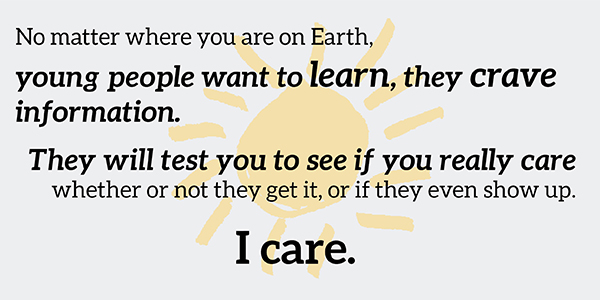
At first they came in scared, terrified, some not knowing the English language, and nearly none of them knowing the language of dance. Though the proficiency levels vary, the feelings of frustration from the challenge is shared. Yet, we are starting to build a community of support and understanding with confident souls that know they CAN! Some of those who stood in the back of the class at first are finding their way to the front and are becoming leaders, helping others and welcoming newcomers.
In dance, the process often begins with what I refer to as the ugly duckling syndrome. “Feeling ‘stupid’ and looking ‘stupid’ is OK,” I tell my students. I remind them that we all looked “stupid” when we were learning to walk as babies but the alternative was to never run and we wouldn’t have that! The process is what makes art making so fulfilling and ultimately what makes a teaching artist so effective. Artists know and respect the strength of the process because we are immersed in it daily. Effectively bringing the idea of process into the classroom has a positive and lasting impact on students.
It is through these processes that students are engaged where they may otherwise be distracted or lack interest. The process instills in young people the ability to effectively gather resources, question, problem-solve, and persevere to see something through to the end, whatever challenges they may face in academy and beyond.
Meet our new artists: Valerie Branch
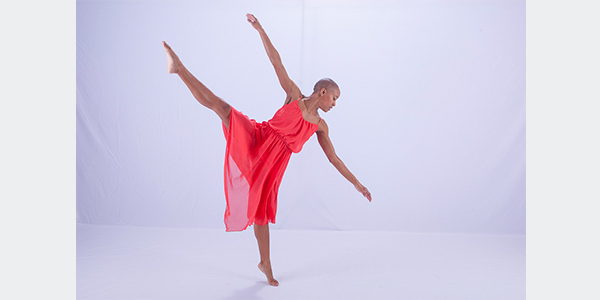
During the last two years, our roster has grown in size to encompass new artists, ensembles, and art forms. From slam poets to improvisers to Capoeira masters, these new artists are undeniably unique.
To introduce audiences to our new artists, we’ll be posting interviews with those who recently joined our roster, giving them a chance to share more about themselves and their experiences with Young Audiences so far.
What is your background as an artist?
I graduated from University of Maryland College Park (UMCP) with a Bachelor of Arts degree in Dance. Since graduation, I have been at the forefront and background of different dance organizations and have traveled around the world as a result of my passion for dance.
The first company I danced with was Lesole’s Dance Project, a traditional South African dance company where I was able to hone in on my leadership, creativity, organizational skills, and learn and appreciate a new form of dance. I served as rehearsal director, administrative and fundraising support staff and learned how to make a dance company successful. The Director and I worked together to create and organize an edu-dance program for young students in South Africa, which we were successful in implementing two years in a row.
In 2011, I was invited to Copenhagen, Denmark as a visiting artist to explore the country’s culture and art. As a result, REVISION dance collaborative (a company in which I co-directed its first season) had the opportunity to perform in and be part of the Kids Euro Festival where we performed in locations throughout Washington, DC.
How did you hear about Young Audiences?
I heard about Young Audiences through Laura Schandelmeir, who had partnered with Young Audiences through the Maryland Wolf Trap program as a teaching artist. Laura was one of my professors at UMCP and is a wonderful dance educator, and someone whom I have had the opportunity to be inspired by.
You recently completed the Teaching Artist Institute (TAI) Seminar this spring. What was your favorite part of the program? How has that experience changed your approach to a program or your teaching practices?
Saying that I loved the TAI program is an understatement. Though I have been working with students within and outside of the classroom for years, I felt that this program truly changed the way I think about and approach my lessons, teachers, and students. I really appreciated Karen Bernstein, the dance facilitator on staff. Karen truly guided and provided me with advice so I could grow. I felt that Karen was the true support that I needed. She gave me feedback when I needed it; let me struggle in order to figure out what I needed to do; and was there when I needed encouragement. So often in programs like this, artists just receive a generalization of arts education/arts integration and then have to figure out: “What should I do with my art form and where do I start?” It was helpful to receive a plethora of examples from different artists. I enjoyed that the staff was fun and made the experience fun.
What made you decide to become a YA roster artist?
I initially joined Young Audiences as a Maryland Wolf Trap Teaching Artist serving preschool classrooms. In my first year on the Young Audiences roster, my opportunities have grown tremendously to reach older students and I am appreciative of that. Being part of the Young Audiences organization, I truly feel like I am growing and developing as an artist–where I am right now in my career is exactly where I want to be. Taking this journey has allowed me to focus on my career, taking everything that I have learned and witnessed throughout the early stages in my career, and create something new.
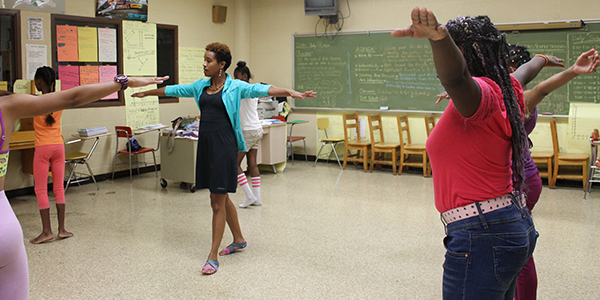
Have you had any programs through YA yet? If yes, what was the most memorable part? If no, what are you most looking forward to?
I love teaching within the classroom and working with the teacher and the students to explore learning and understanding subject matter through movement. I am really looking forward to assemblies!
Why do you believe art is important for every student to have access to?
Children need to be allowed to think creatively and develop their own opinions. They need to develop their critical thinking skills at an early stage so that they have a clear understanding of why they think the way they do and why they feel a certain way about different situations. They have to develop their own understanding of how to accomplish tasks. The arts provide a creative outlet by allowing them to explore, imagine, and test new ideas. The arts target a different area of their brain, and once students have this experience it opens them to new possibilities. It allows them to take risks in the classroom that they may have been shy to before an arts experience. The arts help to develop self-confidence.
What does your art form in particular teach students?
Self-confidence, patience, respect for self and others, and focus. It also gives them an understanding of their own bodies–they find out new and exciting things that their limbs can explore, plus they learn their own limitations and to appreciate what others can do.
Learn more about Valerie Branch Dance Ensemble’s offerings through Young Audiences.
Keep an eye out for more interviews featuring our newest roster artists! See past new artist interviews here.
Reflecting on the Teaching Artist Institute
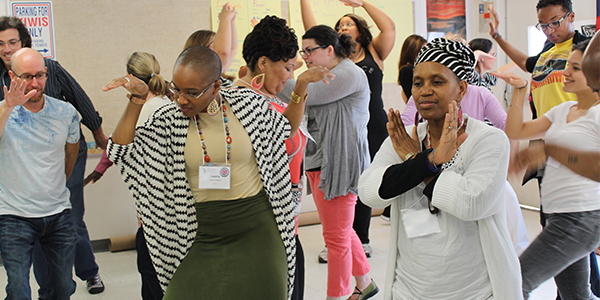
The 2014-2015 Teaching Artist Institute (TAI) Seminar is already underway, but we wanted to share some reflections from artists who have graduated from the program. Here’s what they had to say about the experience:
As a full-time preservationist of acoustic Delta Blues from the 1920s and 1930s, I must make my history of Blues show academically relevant to the curriculums of Maryland and Virginia schools. I completed the TAI training program in 2009, and the course completely transformed my understanding of how I can support the current teaching standards in schools with my music programs.
As Young Audiences knows better than anyone, all the arts are under tremendous pressure to prove their relevance to school systems that are struggling to meet national testing standards in different disciplines. What I learned from my TAI training is that the arts serve a valuable role in preparing students with the 21st Century thinking skills they need for their future success in our rapidly changing world.
By creating a residency with a language arts teacher as my partner, I was able to use songwriting to teach students figurative writing skills. Without the TAI training, my school music programs would not be as academically relevant to the school’s goals. This connection is critical for the arts to survive in our schools, not as a reward for difficult academic work, but as a means to help students meet their academic goals.
The TAI program is well-run by dedicated educators and artists. It is challenging, rigorous, and exposes artists, teaching artists, and professional educators to each other’s thinking styles. This program deserves support, and I hope it continues to transform serious performing artists into skilled teaching artists.
– Curtis Blues, Blues Musician, Exploring Math and Music by Making a One String Guitar
I had never thought of myself as an educator, at least not in the traditional sense. Musically, there is always an underlying truth or teachable moment I try to impart. However, now I needed to do so in a structured, educational format. Although the curriculum was challenging, I am ever so grateful for having gone through the process. The fellowship with the teachers and other artists truly cannot be measured. As an artist, mentally you have to re-wire your brain to remember that it is not about you or a performance; it is about what the children learn and take away from the experience. A few months later I had the opportunity to return to the school for a musical performance for a general assembly. My class was so excited to see me and the feeling was more than mutual. For that reason alone, it was a journey worth taking.
– Uncle Devin, Musician and “Drumcussionist,” Uncle Devin’s World of Percussion

TAI gave me such an appreciation for the life of the classroom teacher. Not only did I learn how to plan and sequence a project into realistic, meaningful lesson plans, I learned a whole new vocabulary and some best practices of a strong teacher as well. Field testing my lessons with my teaching partner gave me real world practice in collaboration, classroom management, solid preparation and flexibility.
TAI is also a rare opportunity to work and learn side-by-side with artists from other disciplines. I met so many energetic, thoughtful, creative people who are not only committed to their art, but also to making a difference in the lives of children. It was incredibly valuable to me to be stretched and out of my comfort zone. As a visual artist, I found that experiences in music, dance and drama helped me move out of my head and in to my body. I learned that this whole body engagement is something that I want to bring to students when I lead them in the visual arts.
On the last day of TAI we were asked to say one word that summed up our experience. My word was “ALIVE.” That pretty much says it all.
– Pam Negrin, Visual Artist, Transformative Textiles: Weaving Together Math, Literacy and History and
Collaborative Stitching: Connecting and Inventing with Needle and Thread
TAI is an amazing opportunity where artists, educators, and staff truly collaborate to help process, define, and designate the importance of art in the classroom. I loved the guided lessons, hands on experience, and being around such amazing, talented individuals. I feel like this experience helped to shine a new light on my own experiences as a classroom teacher and now a teaching artist.
– Bridget Cavaiola and Michael Harris, Baltimore Improv Group, Life is Improvised!
The staff and artists who coached us through TAI opened a whole new level of integrated content, planning, and instructional skills to us. The opportunity to develop new programming for excited young artists, alongside engaged education professionals in so many unique environments has grown our vision as an organization. This fall, three more team members will begin TAI. Best professional development around!
– Matt Barinholtz, FutureMakers, It’s Alive: Kinetic Creature Lab!
I really felt like I was re-energized in my way of thinking and the facilitators brought a plethora of knowledge to the table. I appreciated their ability to listen, answer questions, and make the experience fun, interactive and simply enjoyable.
– Valerie Branch, Modern Dancer, Exploring, Creating, and Dancing with our Friends!
Arts for all

This week, Washington Post reporter Valerie Strauss wrote about why the arts are, more often than not, the first budget cut at public schools serving predominately low-income students–even though much research has supported why the arts are critical to a child’s development. These schools’ tight budgets force them to prioritize the subjects covered in standardized tests that both measure students’ achievement as well as teachers’ ability. Ms. Strauss argues that the focus on testing has forced educators to ignore what they know about the positive and transformative impact of the arts in the classroom.
Less fortunate children have been on the receiving end of what I’d call an emergency-room approach to education —one that addresses only the parts of a child thought to be in most dire need of attention. Their curriculum may consist solely of reading, writing and mathematics – the subjects tested on high-stakes exams.
Ms. Strauss notes how, for privately funded and operated schools, the approach to the arts can be starkly different. These schools proudly highlight the arts and their importance to developing well-rounded students and individuals. With adequate funding, arts learning opportunities are not only available but celebrated.
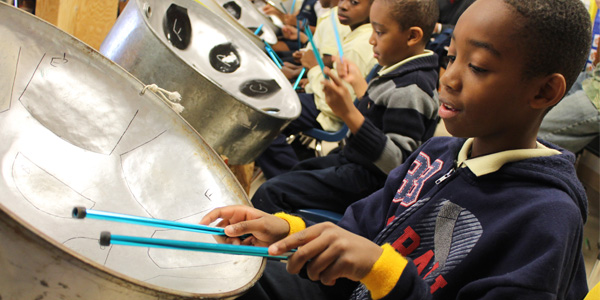
Young Audiences has seen this disparity in access to the arts in Maryland and is striving to close the gap so that all students have the chance to learn in and through the arts. Since its launch in the winter of 2009, our Access for All Initiative has subsidized programs for students in low-income Baltimore City Public Schools to ensure that all students have equitable access to the best artists and educational arts experiences that our state has to offer. The initiative offers three rounds of grant funding each school year to schools that serve a majority of low-income students and do not have regular arts programming.
Young Audiences awarded a total of $29,600 in funding to 16 Baltimore City schools in the first round of Access for All grants awarded earlier this week to start the 2014-2015 school year. These funds will be used to bring Young Audiences artists and ensembles to students through arts-in-education programs this fall. Schools can choose from a steel drum assembly, creating a ceramic mural during an artist-in-residence program, an African drumming workshop, and many more.
Ms. Strauss summarizes why the arts are critical to the education process, writing:
Arts transport. It’s often said they are an essential part of what makes us human – and an element of that is the ability to imagine another reality, apart from the one we are living, a skill essential to resilience and ambition. Children already living a in a narrowed world need more access to the arts, not less.
Young Audiences agrees. One day, every school–no matter its resources–will value the arts for their ability to inspire and engage students in learning. Until then, we will be working to increase access to the arts so that Maryland students have the opportunity to imagine, create, and realize their full potential through the arts.
Learn more about the Access for All Initiative and the next grant application deadline.









